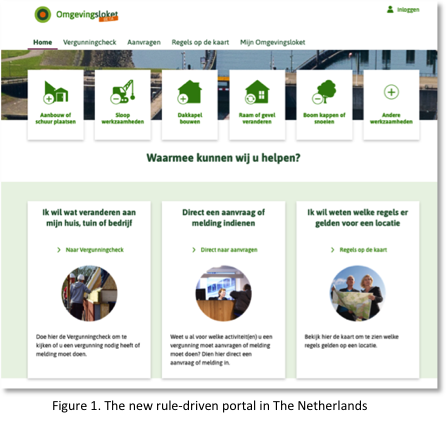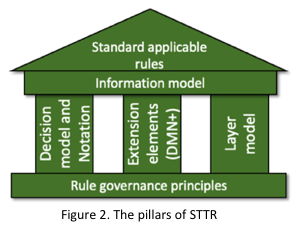A Layered Model Approach for Decision Rule Management: A Guidance in Translating Legal Rules into an Executable Model
Introduction
 A complete revision of the Dutch Environment and Planning Act will go into effect in July 2022 in The Netherlands.[1] Digitalization is a key aspect of this new act. Part of the digitalization is the creation of a rule-driven portal, and thus a great emphasis lies on the governance of decision rules. This paper explains why a new standard for decision rules is set up to support the governance. One of the standard's concepts is a layered model approach for decision rule management. Although the approach is intended for use in the domain of the Environment and Planning Act, the general principle is of interest for all with an interest in decision rule management.
A complete revision of the Dutch Environment and Planning Act will go into effect in July 2022 in The Netherlands.[1] Digitalization is a key aspect of this new act. Part of the digitalization is the creation of a rule-driven portal, and thus a great emphasis lies on the governance of decision rules. This paper explains why a new standard for decision rules is set up to support the governance. One of the standard's concepts is a layered model approach for decision rule management. Although the approach is intended for use in the domain of the Environment and Planning Act, the general principle is of interest for all with an interest in decision rule management.
The Digital System of the Environment and Planning Act and applicable rules
The new Dutch one-stop-shop of the Digital System Environment and Planning Act is a rule-driven portal. Users of this portal need only answer those questions — in the form of a question tree — that are relevant to their plans in their living environment. This relevance is determined by a rule-based engine driven by decision rules. The decision rules — in terms of the Digital System, 'applicable rules' — are made and supplied by both central and regional authorities. For this purpose, the Standard Applicable Rules (hereafter: STTR) is drawn up as one of the new standards for the Digital System.
The STTR and the associated information model are necessary to be able to publish applicable rules in the rules registry of the Digital System. This registry offers rule-driven services for the portal to service its users. With more than 350 different rule-making authorities, it is necessary to make agreements in order to draw up and exchange applicable rules; that is, a standardization is necessary to get syntactically and semantically correct rules delivered in the registry. A municipality and/or a water board and/or a province and/or the central government can all set rules about an activity. In the portal, these rules operate together, where relevant. When applicable rules are drawn up in accordance with the standard and information model, it is a guarantee to be able to store them in the registry and thus execute them in the portal. Therefore, it is also a legal obligation to use the STTR as the standard for decision rules in the Digital System.
The Pillars of STTR
The agreements in the STTR can be seen as three pillars. Although a combined source holdership of 350+ central and regional authorities is special and unprecedented, the structured writing of decision rules based on rule governance principles is of course a field that has existed for some time.
 The first and most important pillar of the STTR is the use of the international standard Decision Model and Notation (DMN) to lay down the decision logic from legal regulations.
The first and most important pillar of the STTR is the use of the international standard Decision Model and Notation (DMN) to lay down the decision logic from legal regulations.
The second pillar of the STTR is a derivative of this, namely the possibility to extend DMN in the STTR based on an option that DMN itself offers: the extension elements [OMG, 2021]. For example, elements that DMN does not provide can be added to the STTR as an extension element to DMN in terms of the STTR. This allows, for example, different types of questions to be linked to the decision logic, or an order of questions can be set to deal with priority in a declarative model.
The third pillar of the STTR concerns the layer model. Much has already been published about DMN itself, and the STTR also has extensive documentation in Dutch [Rijkswaterstaat, 2020]. However, the background of the STTR's layer model has remained underexposed. This paper takes a closer look at the goals of this layer model.
Introduction of the layer model
Applicable rules is a collective term for a set of different types of rules and decisions that together form the set of applicable rules, that is, from the questions to a user to the deduced decision on — for example, a permit check or application requirements. This decision is a conclusion based on other decisions and legal grounds, of which the actual input is given by a user through answers to questions ("facts"). For example, a permit requirement as a conclusion depends on the building height. How high a structure is going to be is only known by the person who is going to build it. The conclusion and the legal grounds therefore belong to the regulatory-based part of the applicable rule, while the fact that gives substance to the legal ground comes from the real world of this person. Legal ground and fact are even further apart when, for example, the legal ground requires "18 years or older"; the fact required will usually be date of birth.
In applicable rules it is also possible to provide specifications about how questions should be shown to the user of the portal. This does not relate to the execution of the declarative logic by the BRE, but to the presentation of questions. Consider, for example, the priority of a question: in a logical interaction, for comprehensibility, some questions will have to be asked earlier than others, or questions must be shown grouped together because they belong together. Specifying this behavior is to be seen as rules to govern the interaction.
The layer model recognizes the different character of rules and therefore offers a functional separation between different types of rules. A characteristic of the layer model is also that specifying applicable rules is a multidisciplinary activity in which legal experts and policy makers work together with information, data, and communication experts.
General explanation of the layers
The layer model is based on four types of layers and additional content. This characterization is not specific to the domain of the Environment and Planning Act and may apply to any rule management domain where an end-user application is developed based on legal rules.

Decision rules layer
This layer is a translation of the legal domain into decision logic. The purpose of the decision rules layer is to lay down the logic as much as possible in accordance with the letter, intention, and structure of the legal rules, also known as the principle of isomorphism.
The legal domain must be interpreted broadly here because this not only concerns legislation and regulations but also, for example, policy and further expert knowledge. Decisions that can be taken based on the legal rules and the required legal grounds are laid down as much as possible in accordance with the legal structure. The purpose of this isomorphic fixation is to:
- Better ensure the traceability between the legal rule and the business rule by the way the logic is reflected. The impact of changes in regulations on the decision logic will be easier and more quickly discovered. In the decision rules layer, a reference to the source ("knowledge source") can be made at decision and legal ground level. If necessary, this can even be added at decision rule level in a decision table.
- Facilitate determining whether decision logic is compliant with underlying regulations.
- Increase recognizability and therefore ability of the decision rules to be validated by legal experts at:
- Model-time (the discussion between the modelmaker and the legal expert is easier because the model forms the common language between them);
- Run-time (questions that are asked to the end user can be traced back via the model to decisions and legal grounds and therefore to the underlying regulations).
The goals of the decision logic layer support the key stakeholders of this layer, such as legal experts, policymakers, and rule analysts, at explicit and structured development, validation, and management of their specific decision rules.
Data rules layer
Where the decision rules layer focuses on translating the legal rules including legal grounds, the data rules layer is intended for modeling the input of facts that are necessary to provide the legal grounds with a concrete value. The isomorphic decision model can thus be "executed" so that decisions can be made based on actual facts.
Regulations usually do not make a statement about where a fact can be found. The legal ground is, for example, whether a house is a monument. The legal ground 'monument' can influence the decision regarding, for example, the need for a permit. Whether this fact can be deduced from a registry or whether this fact must be collected from the end user is irrelevant to the regulation. The data rules layer provides the ability to further specify this implementation aspect without affecting the decision logic. This optimally separates logic and implementation but connects them through the link between the layers.
In the STTR, different types of data rules are used, such as asking a user through a question or directly using facts from a registry. It is also possible to use actual geometry locations as facts [Van Dijk, 2020]. These locations, in turn, follow from regulations in which geometry objects are determined — for example, the catchment area of a river or the city center of Maastricht.
This leads to a separate unit of management for the implementation, and that is exactly what the goal is, since the drafting and management of data rules is usually the domain of rule analysts, information experts, and/or data specialists. Moreover, by linking the data rule with the decision rules via the legal ground, traceability is guaranteed from legal ground to fact.
Conversion rules layer
Conversion rules may help to connect data rules and legal grounds when the data types differ. In the decision rules layer, the logic is laid down as it is included in the legal rules. Data rules focus on giving input to legal grounds based on facts.
The legal ground may semantically be the same as the fact, but translation problems can sometimes arise. For example, the legal ground may be "eighteen years or older" whilst the fact is the date of birth. For the legal ground, the date of birth could be chosen to incorporate further in the logic. However, this will include an implementation aspect in the decision rules layer and that can quickly make the legal models appear different from the actual legal source and thus be a violation on the principle of isomorphism.
Another reason is that decision rules do not need to change when only the provision of information changes. That is precisely what can often make a mixture of legal logic and implementation aspects complicated.
A further reason is the need for a user-friendly way of asking questions (or even a way of asking questions where you will give the end user an insight into the legal norms that are at stake) — for example, to give the end user insight into the boundary for the height of a building. The question then indicates, for example, the limits of that building. You want to be able to adjust these communication considerations without it having a direct effect on the decision logic, which should be based on the legal rules.
For these reasons, in the conversion rules layer a translation can be made of facts from the outside world to legal grounds with the aim of keeping both layers pure. In this layer, in particular, rule analysts and information experts will work closely together.
Interaction rules layer
The interaction rules layer provides the ability to further specify the behavior (the "interaction") when executing applicable rules. Behavior here specifically means the presentation of the questions — based on the data rules — in a user application.
- In the data rules layer, the where and what are specified: where a fact can be obtained (from which source) and (if applicable) what the question is for the end user.
- In the decision rule or conversion rules layer, the link between legal grounds and data rule is made.
- In the interaction layer, in addition to the what and where, the how is specified: how the questioning of facts should be presented. These are attributes such as indicating in which group a question belongs or the priority in questioning. (Simple) input checks can also be specified in this layer.
Interaction only specifies the presentation and has no legal meaning. Therefore, this layer has no influence on the interpretation of facts or the deduction of a conclusion. After all, that is the role of the decision rules layer. If a user-friendly experience is irrelevant (for example, when deciding automatically without any user interaction), then the interaction rules layer could even be omitted. The rule engine continues to operate based on declarative logic, as specified in the decision rules layer. Due to the nature of the "forward reasoning" algorithm of the rule engine, the algorithm always indicates the complete set of data needed to reach a conclusion. What the interaction layer does is show to the user the collection of questions for data, which the rule engine needs at any time to reach a conclusion, in the specified order and grouping. A good decision model in combination with a corresponding "logical" interaction specification gives so much control that it seems as if you are "overriding" the operation of the rule engine or as if it would work procedurally instead of declaratively.
Here, as well as for the other layers, the unit of management is relevant. How information should be shown to end users is more the domain of information and communication experts than of legal experts or policy makers.
Content layer
 The content layer is not a stand-alone layer but is complementary to the other layers. Questions may require further explanation, conclusions may need an explanation, or a group could be provided with an explanation. On various parts it may be necessary to add an explanation in the form of text, images, links to informative websites, or instructional videos. However, if questions or conclusions need a lot of explanation, the question can be asked whether the decision rule model has been fully elaborated.
The content layer is not a stand-alone layer but is complementary to the other layers. Questions may require further explanation, conclusions may need an explanation, or a group could be provided with an explanation. On various parts it may be necessary to add an explanation in the form of text, images, links to informative websites, or instructional videos. However, if questions or conclusions need a lot of explanation, the question can be asked whether the decision rule model has been fully elaborated.
Communication experts, decision rule makers, and possibly also legal experts will be able to determine together whether an explanation should be added or adjustments should be made to the decision rule or implementation rule layer. Legal (source) references to establish traceability between decision rules and legal sources are not part of the content. This traceability is precisely recorded in the decision rules layer for the purpose of manageability and compliance.
Conclusion
The layer model as explained in this paper provides guidance in translating legal rules into an executable model based on the rules from the various layers. It helps to keep apart implementation aspects from the logic. Various experts from various disciplines can work together on the model as a whole. It offers them the possibility to work on, manage, and change the relevant parts for their focus points. By dividing applicable rules into different layers in the rule management process, the complexity and manageability of applicable rules can be reduced. Given the advantages mentioned in the layers, it offers a school of thought about the design of the rule management process, both conceptually and technically as well as tool-wise.
Notes
[1] More information about the Environment and Planning Act can be found at https://www.government.nl/topics/spatial-planning-and-infrastructure/revision-of-environment-planning-laws
References
OMG (Object Management Group), 2021. Decision Model & Notation (DMN), 6.3.16, https://www.omg.org/spec/DMN/1.3/PDF.
Rijkswaterstaat STTR, 2020. Specification STTR, Description Standard Applicable Rules, Program Implementation Environment Act.
Van Dijk, V. and Bleeker,R., 2020. Smart combination of legal rules and geo-information to support spatial development projects, FIG 2020.
# # #
About our Contributor:
Online Interactive Training Series
In response to a great many requests, Business Rule Solutions now offers at-a-distance learning options. No travel, no backlogs, no hassles. Same great instructors, but with schedules, content and pricing designed to meet the special needs of busy professionals.












